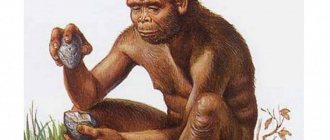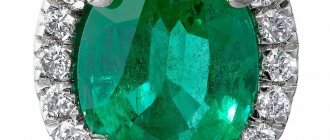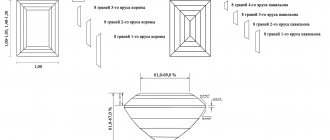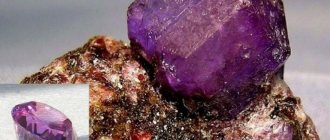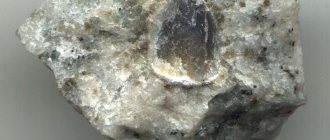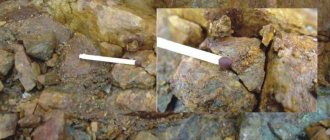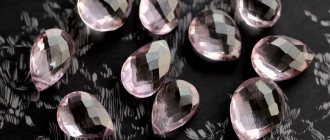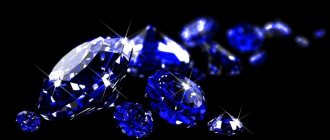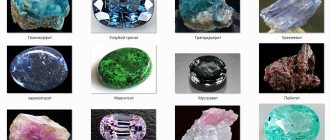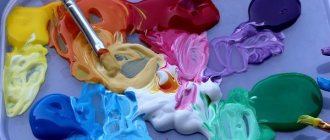The world of precious stones and gems is vast and fascinating. Bright and fascinating crystals have been used since ancient times to make jewelry and used as banking assets. Each mineral has an individual history, color and properties. Nowadays, the science of gemology deals with the study of precious stones. Modern methods of classifying minerals differ from old methods and allow us to better understand the whole variety of precious and ornamental stones.
What is a gem
Gems are a historical and everyday term used to designate precious, semi-precious and ornamental stones used in jewelry and decorative and applied arts or as ornamental raw materials. According to the classification of Academician A. E. Fersman, only transparent stones can be considered gems, regardless of which group they belong to, and opaque specimens are usually classified as colored stones. However, now the term “gems” can be used in relation to any mineral, be it an ornamental or precious stone.
Additional ideas
If the fish are supposed to be “launched” into the aquatic environment, then the tail and fins can be cut from transparent plastic from unnecessary plastic bottles of different colors. This material is truly universal. It is possible to obtain a variety of decorative elements from it; it is easily cut, processed and takes the desired shape.
For example, thin, long and slightly curled strips will make a great tail for our “goldfish” (especially if you take a brown or yellow bottle). Small scraps of plastic will produce hard, sharp “fins” that can be glued to the backs of the fish.
A decorative aquarium can be filled with real plants in small pots, which are masked with the same sea pebbles. And if, in addition, you organize special lighting for it and carefully think through the composition, such an aquarium will decorate any room - a living room, hallway or children's corner.
Properties of gems
The following features are characteristic of precious stones:
- Rarity. Some varieties of gems are expensive due to their uniqueness, as they are difficult to find and obtain. The depletion of mineral deposits also affects the demand and cost of individual species.
- Hardness. The durability of gemstones directly depends on their strength, which is influenced by hardness, cleavage and other physical properties.
- Appearance - this takes into account not only the initial appearance of the mineral after mining, but also how the gem will look after processing. Jewelers evaluate clarity, color, pattern, light refraction, shine and polishability.
- Origin. Scientists have learned to create imitations of stones by growing crystals in laboratories or by coloring less valuable natural specimens to pass them off as another stone. Despite the fact that fakes sometimes look more beautiful and more durable than natural minerals, the latter are still valued higher.
- Compactness. Small gemstones have been used since ancient times to this day as a measure of value. Most expensive minerals are small in size. The discovery of large crystals is considered extremely rare.
Decorating the interior of the apartment
Using the same principle, you can make a rug for the bathroom or for the threshold. It is best to stick the stones onto a rubber base, which can be used as a regular commercial mat. By placing your feet on this exclusive product, you massage active points and improve your health.
Another useful element of the hallway interior is a shoe stand in the form of a flat tray into which a layer of stones is poured (even without glue). Original and practical! An exclusive floor lamp “from the Stone Age” can be made by drilling several round stones and placing them like a child’s pyramid (large ones at the bottom for stability) on the metal leg of a disassembled lamp.
If you have already decided to decorate the hallway in a “stone” style, try decorating the frame of a wall mirror in a wooden frame with pebbles. It should turn out very stylish and unusual. The gaps between large pebbles are filled with small shells and stone chips.
Description of gems
Gems are divided into translucent and transparent. The weight of different stones varies from several grams to hundreds of kilograms. For example, the largest ruby weighs 459 g, and topaz crystals can reach a couple of hundred kg.
The color of the stones also varies: expensive diamonds are colorless, like a teardrop, while emerald has a rich shade of fresh greenery. The uniqueness of color, properties, weight and origin makes each precious and semi-precious stone one of a kind, which jewelers successfully use when making unique jewelry.
Fluorite
The original, cubic-shaped mineral is actively used in the production of applied art products.
One of the most unique properties of this mineral is its slight glow in the dark. Today in science fluorite is used to make lenses.
3
Classification of stones
Gems differ from each other in various ways, so people have a need to classify them. There is no single division: jewelers classify crystals according to one characteristic, gemologists - according to another, and sellers are only interested in the cost of the specimens.
The first attempts to classify minerals belonged to Professor K. Gurich. Some time later, in 1986, Bauer brought greater clarity to the description of stones, dividing gems into three types:
- precious;
- ornamental;
- organic stones.
But many other rocks were not included in this characteristic, so currently most experts use the classification according to V. Ya. Kievlenko, who ordered the stones as follows:
- Jewelry - the group includes expensive and rare minerals, which are divided into 4 orders.
- Jewelry and ornamental gems - like the first category, are divided into orders.
- Ornamental stones - used for making jewelry and interior items.
For clarity, you should familiarize yourself with the table, which contains a list of the names of minerals included in one or another category.
In addition to this classification, gems are usually divided according to geography. Different types of stones are mined all over the world, but the most famous are the gems from Siberia and hot countries.
For example, at the foot of Mount Kilimanjaro there are deposits of rare and expensive tanzanite. Asia is known for its deposits of large sapphires and rubies, and Japan produces record quantities of cultured pearls. In Russia there are the famous Ural deposits, where malachite, amethyst, topazes and even emeralds are mined. It is interesting that in the old days blue Ural topazes in Europe were given the name “Siberian diamonds”. It is worth mentioning Yakutia - expensive diamonds with a high degree of purity are mined here.
There is a division of minerals depending on the nature of their formation. Classification of natural stones by origin:
- Igneous. As erupted magma cools, various minerals form within the earth. Gems begin to grow in the cavities of rocks, creating rubies, sapphires or topazes, and the difference between the stones is due to the chemical composition or viscosity of the magma.
- Metamorphic - formed under the influence of physicochemical factors in the bowels of the earth, which affect the layers of the soil. Under the influence of various factors, breeds are transformed. This group includes, for example, garnet, marble and feldspar.
- Organic. The peculiarity of representatives of this group is that once upon a time the stones were something living, and then they turned to stone. A striking example is pearls, which are formed in shells as a result of the coating of foreign inclusions with mother-of-pearl, or amber, which is the petrified resin of trees.
Other ideas for the garden and kitchen
Let's go to the kitchen. What crafts made from sea stones are possible here? An alternative version of the protective screen (as opposed to the usual tiles) is the same pebbles laid out on the surface of the wall. It costs nothing for craftsmen to unscrew standard handles from kitchen cabinets and replace them with flat stones. You just need to take care of the reliability of the fastenings.
Now let's go back to the garden. In addition to the beds, paths are laid with stones, and if there are enough of them, they build fences, original decorative fountains, and even use them to create furniture. For example, as the base of a garden bench.
Another option for using this wonderful natural material is decorative figurines and garden sculptures. Here, nothing limits the flight of creative imagination. The stones are grouped, glued, painted, decorated with whatever your heart desires. Crafts from sea stones, photos of which you see in this article, can be made by anyone.
As a result, we see bright ladybugs, frogs, caterpillars, snails... You can make “vegetables” and “fruits”; “mushrooms” are especially popular, placed in different corners of the garden. Large stones of suitable shape are painted in the form of tigers, sharks, crocodiles, dogs, cats and even fairy-tale gnomes or elves. Decorative pots or buckets filled with “strawberries” or “apples” made from painted stones will serve as an original decoration for the garden.
Separation of gems by color
The name “gem” indicates that each stone has an individual color. In the old days, it was believed that the shades of minerals were not random - magical abilities and healing properties were attributed to each color. In the modern world, there is a special science - color psychology, which studies the influence of colors and shades on humans.
The choice of stone color for jewelry plays a big role.
Scarlet is a symbol of movement, so rings and earrings with ruby are suitable for active and enterprising people.
When choosing a precious item, you need to take into account the main character traits of the future owner.
Purple
The color purple symbolizes wisdom and inner intuition and helps to achieve hidden secrets. Among the gems of purple and lilac shades, the following stand out:
- Ametrine - combines two minerals: citrine and amethyst. It is considered rare because it is mined only in one place - in the mines of Bolivia. Areas of lemon and purple colors are combined unevenly or zonally.
- Amethyst is a purple variety of quartz, a rare and beautiful stone. The amethyst palette includes different shades that give the color richness and depth.
- Kunzite is a mineral discovered recently, but immediately fell in love with due to its unusual color. Color - violet with shades of pink and light red.
- Sugilite is one of the youngest precious minerals, ranging in color from purple-blue to light pink. It is mined only in a few places around the world, so it is considered expensive and rare.
- Jade. Lavender stone is the rarest representative of the jade group. It is mined in the Urals and Kazakhstan.
- Charoite is a stone with a mysterious name mined in Russia. Thanks to the manganese it contains, the color of the gem varies from light lilac to violet.
Ametrine
Kunzite
Sugilite
Charoite
Blue
Minerals and gems with blue colors are considered one of the most beautiful and expensive. The value of natural sky-colored stones is due to their rarity and the fact that the blue color represents greatness and knowledge. Sometimes jewelers specially tint inexpensive minerals to achieve a uniform blue tone, as this increases the cost of the item.
Among natural blue gems, the following stand out:
- Sapphire is the king of blue stones, because even the name of the mineral is translated as “blue.” There are sapphires in other colors, but azure ones are the most expensive.
- Lapis lazuli is a soft and brittle mineral, colored in various shades of blue and blue.
- Turquoise. The stone has been loved and known to people since ancient times. The color of turquoise varies from light sky to blue-green shades.
- Benitoite is a beautiful mineral with a deep blue color. Considered expensive due to scarce deposits.
- Indigolite is a rare variety of tourmaline that can be dark blue, black-blue or sea green.
Turquoise
Sapphire
Lapis lazuli
Indigolite
Reds
Red crystals and gems symbolize fire, passion and energy and have been highly valued at all times. Among the fiery minerals, there are both inexpensive representatives, for example, corals, and valuable ones, such as fiery rubies.
Gems of scarlet tones:
- Ruby is a type of corundum, one of the most valuable stones in the world along with diamonds and sapphires. The color palette includes rich dark red tones and light scarlet shades.
- Hyacinth is a precious red-brown gemstone with a diamond shine.
- Almandine is a variety of red and scarlet-violet garnets. The color of almandines can be purple or cherry red.
- Carnelian is a red-pink or scarlet-yellow variety of chalcedony.
Almandine
Hyacinth Carnelian Ruby
Greens
Green is the color of life and health, so natural minerals in emerald shades were given great importance. It is believed that stones in a shade of fresh greenery calm the nerves, prolong life and bring harmony. In addition to these qualities, jewelers and buyers value “herbal” gems for their rich color.
The group of green minerals includes:
- Emerald is a rare precious crystal. The color ranges from light green to dark green. It is worth noting that emeralds without defects are more valuable than diamonds.
- Jade is a mineral colored in light shades of green, used as an ornamental material and for making decorative items.
- Malachite is a gem of a deep dark green tone. The largest deposits of malachite are located in Russia.
Malachite
Emerald
Nephritis
Yellow
Gold, lemon, orange are shades of happiness, good luck and material well-being. Jewelry inlaid with golden stones can bring luck to the owner’s life, which is why yellow gems are among the best-selling:
- Amber is a stone with an amazing origin. This is the resin of coniferous trees, frozen millions of years ago. In nature, there are specimens of yellow and dark-golden flowers, as well as greenish and silver ones.
- Citrine is a variety of quartz that is recognized for its ease of processing. The color of the gem includes all shades of yellow.
- Heliodor is a type of beryl. It lends itself well to cutting and has a wide palette of sunny tones.
- Topaz is a golden-yellow mineral that is highly reliable and durable.
Heliodor
Topaz
Citrine
Amber
Kemmererite
Ra'ike (see also: de:Benutzer:Ra'ike) ,
A fragile mineral consisting of monoclinic-prismatic crystals, immortalized in its name the name of the Russian mining engineer Alexander Kemmerer.
Géry PARENT,
Violet and red minerals with a glassy, pearlescent tint are found in nature.
4
Products made from gems
Precious and semi-precious stones have long been valued by people due to their bewitching beauty and dazzling brilliance. Minerals were used for healing and magical rites . It was believed that wearing minerals could cure terrible diseases or poisonous snake bites.
Durable and sparkling gems not only “treated”, but also helped ancient people develop. Weapons, knives and axes were made from stones, then used to make things. However, the most valuable were the minerals used in jewelry. Various decorations were created from them:
- bracelets, brooches and rings;
- necklaces, beads, pendants;
- tiaras, crowns, crowns and earrings.
Thanks to the skill and labor of jewelers, there are products that have no equal in beauty.
For jewelry intended for the nobility, only expensive stones were used - diamonds, sapphires, emeralds, and other dazzling and sparkling gems.
Poorer people were content with products with jasper and agates.
Among the most famous gems, the following are especially amazing:
- The Hope Diamond is a huge bluish stone weighing 45.52 carats. Diamond is the most durable gem and is considered the king of minerals. The Hope Diamond is now set in a necklace and kept in the Smithsonian Institution.
- The Tiffany Diamond is a yellow diamond of amazing beauty weighing 128 carats. The crystal is set into a diamond necklace and displayed in Tiffany's flagship store in New York.
- Tiara made of emeralds. The decoration was created in 1900, and the tiara was owned by Princess Katharina Henckel von Donnersmarck. It was created using 11 pear-shaped Colombian emeralds, diamonds, silver and gold.
- The “Incomparable” necklace is considered the most expensive in the world. Consists of a yellow diamond weighing 407 carats and many diamonds weighing 230 carats. It is noteworthy that the crystal crowning the necklace was found by a little girl from the Republic of Congo in a pile of ordinary stones.
- Faberge eggs are a famous series of jewelry created by Carl Faberge and his assistants. The series consists of 71 items made of precious metals and inlaid with gems. Only 65 eggs have survived to this day, some of which are kept in museums.
- The Rosser Reeves Star Ruby is the largest star ruby in the world and has an asterism effect.
Faberge Egg
Diamond Hope
Necklace - “Incomparable”
DIY technology
For work, in addition to pebbles, paint and brushes for them, superglue, various materials for decoration (whatever you can find) - scraps of fabric and fur, beads, threads or yarn, small feathers. Accessories in the shape of the “eyes” of characters are sold in sewing supply stores, but you can also replace them with colored beads or cute flat small buttons.
Pebbles must be thoroughly washed and dried before work. Glue eyes onto the “face” stones, you can draw noses or glue large beads or wool balls instead. Smiling mouths are painted with paints or “laid out” from bright woolen threads. You can also draw them on colored paper, cut them out and glue them. After this, make hair and beards for the gnomes from fur, thread, feathers or fluff - whatever is at hand.
The bodies of the gnomes, like the caps, can be easily made from colored scraps, sewing them in the shape of a cone and filling them with something like cotton wool or scraps of padding polyester. Using strong glue, the heads are attached to the bodies - the funny figures are ready!
The magical power of crystals
Since ancient times, gems and minerals have been valued by people not only for their external beauty, but also for their magical properties. Sorcerers and healers used stones to treat the sick, rituals and offerings, and the abilities of gems were glorified in ancient legends. Nowadays, jewelry stones are used in lithotherapy, where diseases are treated in an unconventional way.
Each of the natural gems has individual strength and properties:
- Agate is a mineral that will give you long life and health, and will help you recognize the enemy in your neighbor.
- Amethyst is the gem of people in love. Wearing a product with amethyst will help relieve internal pain and relieve stress, and will protect you from drunkenness.
- Lapis lazuli is a stone that will relieve insomnia, eliminate skin ailments and improve blood circulation.
- Jade - in ancient times, the mineral was considered a “kidney” gem. People thought that wearing jade jewelry would cure kidney disease.
- Garnet is a gem that relieves arthritis and joint pain.
- Ruby is a stone that can give its owner power, strength and determination of spirit and will lead to the goal.
- Tourmaline and carnelian are love minerals that will help you find love.
- Emerald is a money talisman. Wearing an emerald helps build relationships with beneficial people.
- Aventurine is a gem that can restore vital energy and good spirits.
- Sapphire is a precious stone that develops thinking and abilities, awakens a thirst for knowledge.
- Topaz is a mineral that protects against depression, helps calm nerves and calm emotions.
- Aquamarine is a symbol of tranquility and the sea, protecting travelers from misfortunes on the road.
- Diamond - a mineral changes the character of the owner, awakening the best qualities: determination, self-control.
- Alexandrite is a stone useful in the fight against aggression and anger.
- Opal is a precious gem that helps you gain confidence in your own abilities and restore your emotional state. Able to warn the owner about diseases by changing color.
- Citrine is a precious stone that will bring success in business and work, give energy and relieve laziness.
- Amber is a mineral that will restore cheerfulness and eliminate negative thoughts.
Agate
Aquamarine
Petrified wood with opal veins
Opal itself is one of the most unusually beautiful minerals. But here the veins of opal are organically and harmoniously arranged in a piece of petrified wood.
Organics and chemical crystals, combining in such a bizarre way, made this stone a real masterpiece of nature.
5
Legends about gemstones
Precious gems, mined since ancient times, have their own history of birth. Many of the minerals are mentioned in ancient legends and tales that have survived to this day.
The myth of amethyst
The history of the appearance of amethyst is closely connected with the god of wine and fun, Dionysus. According to legends, when Dionysus got drunk, he became angry and aggressive. At the time of the next feast, God became so angry that he ordered to kill people on his way and, by the will of fate, met the nymph Amethyst. Having prayed to the gods, Amethyst asked to protect her from the lions of Dionysus, and the gods had mercy, turning the nymph into a frozen stone.
Waking up the next day, Dionysus did not believe that it was his fault that the nymph turned into a statue. The God of Fun tried to revive Amethyst with wine, but the attempts were useless - the stone only turned purple. This is how the precious amethyst crystal appeared.
The Tale of Onyx
Onyx is an ornamental striped gem, the legend of which is associated with the Greek goddess of love Aphrodite. According to legends, when Aphrodite fell asleep, Eros, playing with a bow, accidentally released an arrow and hit his mother’s hand. Aphrodite's fingernail fell to the ground and turned into a striped mineral. In support of this, the name of the gem is translated from Greek as “nail”.
Ruby - dragon stone
There are many legends and stories about the ruby, but the most interesting of them is related to dragons. According to ancient legends, rubies appeared from the eggs of the dragon Naga and ripened in the depths of the earth, filling with scarlet color. Some of the priests believed that the scarlet minerals were the tears of dragons, which flowed from the eyes of mythical creatures when the dragons died. Interestingly, the philosopher Plutarch adhered to this same version.
Gorge of Diamonds
Diamond is the most durable gem, and has long been valued above other minerals. According to legend, a long time ago there was a gorge, the bottom of which was strewn with precious diamonds. However, the gems were guarded by poisonous snakes, and it was impossible to get to the stones. Then people came up with a way to get treasures - they dropped pieces of raw meat to the bottom of the gorge, to which diamonds stuck, and then mountain eagles carried away the stones along with the prey.
Natural gems are a creation given to humanity by nature. It was believed that each mineral has its own soul and properties, thanks to which the stone works miracles. Even if we discard claims that gems have magical powers, the beauty, strength and dazzling brilliance of minerals are undeniable. From ancient times to this day, precious gems have fascinated and attracted the human eye with their play of light and radiance.
How to decorate a refrigerator
Every family with children has refrigerator magnets. But we will have unusual ones - made of pebbles! Let's make magnets in the shape of monsters. Flat pebbles, washed and dried, are painted on both sides in bright colors. After drying, we draw creepy mouths with bared teeth for the “monsters” and glue on the eyes.
We attach a magnet to the back of each stone with superglue. If the stones are large and heavy enough, use a pair of magnets. The original decoration for the refrigerator is ready!
It is best to make bright fish from oval-shaped pebbles, as well as birds with unusual plumage. You can also make a mouse. In addition to pebbles and superglue, prepare scissors, paper and colored scraps. Ears and a tail for the future mouse are cut out of fabric and glued in the right places onto an oblong gray stone. Smaller pebbles will serve as paws, and bundles of threads will serve as antennae. Glue on the eyes (you can use them in pairs in the form of paper circles - wider white ones at the bottom, smaller black ones on top). So the cute mouse is ready.
If you prefer a bird, then take a rounder pebble and make a beak from a fabric of a suitable color (fold the piece into a triangle with a sharp end, glue the wide side to the pebble head). Mark the eyes in the right place, take care of the plumage. Ready!
Rose quartz
One of the most popular minerals, you've most likely seen rose quartz jewelry on someone you know more than once. The love for this stone is understandable - it helps with diseases of the nervous system and heals mental trauma (which is especially important for those who have experienced a difficult breakup). Moreover, it is believed that rose quartz jewelry helps unmarried girls find someone with whom they can build a strong family.
Natural stone materials types
The following most important types of rocks and natural materials are most widely used in construction:
- I. Igneous (igneous) rocks: a) deep-seated massive: granites, syenites, diorites, gabbro;
- b) massive eruptions: porphyry, porphyrite, diabase, basalt, andesite, trachyte;
- c) loose clastic: volcanic ash, pumice;
- d) clastic cemented: volcanic tuffs.
- a) chemical precipitation: gypsum, anhydrite, some types of limestone, dolomite, magnesite, calcareous tuff;
- a) modified igneous rocks - gneisses;
The use of natural stone materials in our construction is constantly increasing, new regional quarries are being organized with comprehensive mechanization of the extraction and processing of stone, crushed stone, gravel and sand, as well as piece stone products.
Azurite
A brittle mineral with a high copper content is often called “copper blue” or “copper blue” because of its color.
The largest deposits of the beautiful mineral are in Africa, but in Europe, near Lyon, France, large specimens of the sky-colored mineral were found in the Chessy quarry.
8
Scolecite
Another beautiful needle-shaped mineral from the zeolite group. Beautiful bunches of transparent crystals form bizarre shapes of a natural mineral.
When exposed to fire, the ray-shaped crystals begin to curl and resemble worms. This property gave the name to the mineral - “scolex” in Greek means worm.
13
Wedgeclase
An amazing and rare bluish-green mineral was first discovered at the beginning of the 19th century in England.
The collectible mineral, due to the oblique angle of cleavage of the crystals, received its name from the merger of two Greek words “klineis” - “oblique” and “klas” - “to split.”
7
Tanzanite
The stone is of a surprisingly noble, rich purple hue. Tanzanite is considered a symbol of love and luxury. They say that it helps to “skip” several steps on the career ladder and enter into a successful marriage - perhaps without unbridled passion, but full of mutual respect, harmony and understanding.
Torburnite
Beauty and mortal danger are reunited in this light greenish mineral.
Torbernite contains a large amount of uranium, and when heated, the mineral crystals emit radon gas, which is dangerous to human health.
And the mineral was named in honor of the 18th century Swedish chemist and mineralogist Thorbern Bergman. Most-Beauty.ru recommends that you admire this stone from a distance.
6
Blue opal "Universe"
Due to the different content of water and other chemical elements, opal can take on numerous colors: from black to light yellow.
This specimen of the mineral is unique in its transparency interspersed with elements, reminiscent of the fascinating world of the vast Cosmos.
The largest deposits of this beautiful mineral are in Australia; the largest opal, weighing 5 kilograms, was also found here.
15
Rhodochrosite
An ancient gem that has a more romantic name - “Inca rose”. Rhodochrosite can provide relief to those suffering from gastrointestinal disorders, kidney and blood diseases. This rare stone also improves memory and enhances libido.
Amethyst
A very popular gem of a beautiful purple hue. “Amethyst” is translated as “not drunk” - it has long been believed that the stone protects against the harmful effects of alcohol and helps those who are inclined to abuse strong drinks to learn to feel their limits. Esotericists claim that amethyst can teach a person purity of thoughts, steadfastness of life principles and devotion to ideals.
